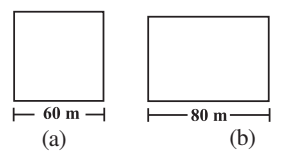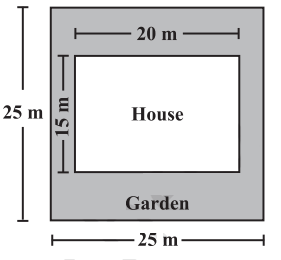NCERT Solutions Class 8 Mathematics
Chapter – 11 (Mensuration)
The NCERT Solutions in English Language for Class 8 Mathematics Chapter – 11 Mensuration Exercise 11.1 has been provided here to help the students in solving the questions from this exercise.
Chapter 11: Mensuration
- NCERT Solution Class 8 Maths Ex – 11.2
- NCERT Solution Class 8 Maths Ex – 11.3
- NCERT Solution Class 8 Maths Ex – 11.4
Exercise – 11.1
1. A square and a rectangular field with measurements as given in the figure have the same perimeter. Which field has a larger area?

Solution – Side of a square = 60 m
Length of the rectangle = 80m
Perimeter of the square = 4 × (side of square)
= 4 × 60m
= 240m
Perimeter of rectangle = 2 × (length + breadth)
Perimeter of square = Perimeter of rectangle
240 = 2 (length + breadth)
240 = 2 (80 + breadth)
240 = 160 + 2 × breadth
240 – 160 = 2 × breadth
80 = 2 × breadth
breadth = 40 m
Area of the square = side × side = 60 × 60 = 3600 m2
Area of the rectangular field = length × breadth = 80 × 40 = 3200 m2
Thus, area of square is larger than the area of rectangular field.
2. Mrs.Kaushik has a square plot with the measurement as shown in the figure. She wants to construct a house in the middle of the plot. A garden is developed around the house. Find the total cost of developing a garden around the house at the rate of Rs. 55 per m2.

Solution – Side of the square plot = 25 m
Area of the square plot = square of the side = (side)2
= (25)2
= 625
Therefore the area of the square plot is 625 m2
Length of the house = 20 m and
The breadth of the house = 15 m
Area of the house = length×breadth
= 20 × 15
= 300 m2
Area of the garden = Area of the square plot – Area of the house
= 625–300 = 325 m2
∵ The cost of developing the garden per sq. m is Rs. 55
The cost of developing the garden 325 sq. m = Rs. 55 × 325
= Rs. 17,875
Hence the total cost of developing a garden is around Rs. 17,875.
3. The shape of a garden is rectangular in the middle and semi-circular at the ends as shown in the diagram. Find the area and the perimeter of this garden [Length of rectangle is 20 – (3.5 + 3.5 meters]

Solution – Total length = 20 m
Diameter of the semi-circle = 7 m
Radius of the semi-circle = = 3.5 m
Length of the rectangular field = 20 – (3.5 + 3.5) = 20 – 7 = 13 m
Breadth of the rectangular field = 7 m
Area of rectangular field = l×b
= 13 × 7= 91m2
Area of the two semi-circles = 2 × × π × r2
= 2 × ×
× 3.5 × 3.5
= 38.5 m2
Area of garden = 91 + 38.5
= 129.5 m2
Now, the perimeter of the two semi-circles = 2πr = 2× × 3.5
= 22 m
And the perimeter of the garden = 22 + 13 + 13 = 48 m.
Thus, the area of the garden is 129.5 m², and the perimeter of the garden is 48 m.
4. A flooring tile has the shape of a parallelogram whose base is 24 cm and the corresponding height is 10 cm. How many such tiles are required to cover a floor of area 1080 m2? [If required you can split the tiles in whatever way you want to fill up the corners]
Solution – Base of flooring tile = 24 cm = 0.24 m
Corresponding height of a flooring tile= 10 cm = 0.10 m
Now Area of flooring tile= Base × Altitude
= 0.24 × 0.10
= 0.024
Area of flooring tile is 0.024m2
Number of tiles required to cover the floor = Area of floor/Area of one tile
= = 45000 tiles
Hence 45000 tiles are required to cover the floor.
5. An ant is moving around a few food pieces of different shapes scattered on the floor. For which food-piece would the ant have to take a longer round? Remember, circumference of a circle can be obtained by using the expression C = 2πr ,where r is the radius of the circle.
 Solution –
Solution –
(a) Radius = =
cm = 1.4 cm
Circumference of semi-circle = πr
= × 1.4 = 4.4
Circumference of the semi-circle is 4.4 cm
Total distance covered by the ant = Circumference of semi-circle + Diameter
= 4.4 + 2.8
= 7.2 cm
(b) Diameter of semi-circle = 2.8 cm
Radius = =
cm = 1.4 cm
Circumference of semi-circle = r
= × 1.4 = 4.4 cm
Total distance covered by the ant = 1.5 + 2.8 + 1.5 + 4.4
= 10.2 cm
(c) Diameter of semi-circle = 2.8 cm
Radius = =
cm = 1.4 cm
Circumference of semi-circle = πr
= × 1.4
= 4.4 cm
Total distance covered by the ant = 2 + 2 + 4.4 = 8.4 cm
Thus, the ant will have to take a longer round for food piece in (b) because the perimeter of the figure given in (b) is the greatest among all

Leave a Reply